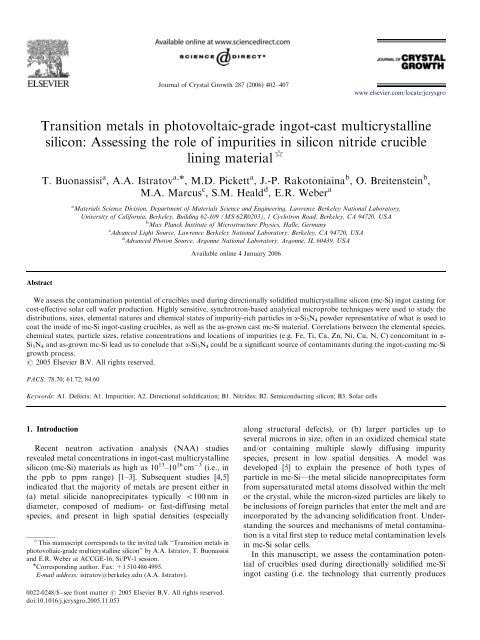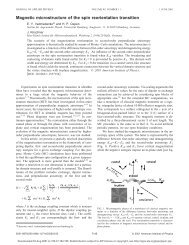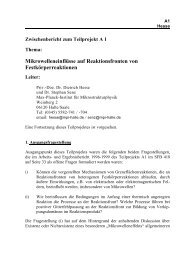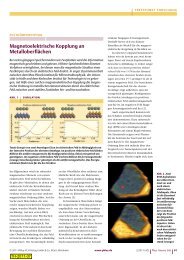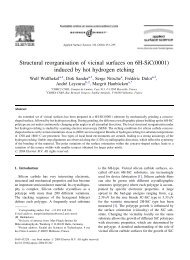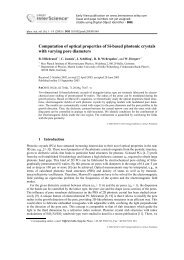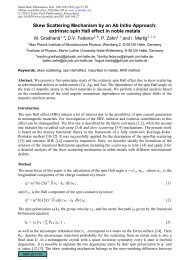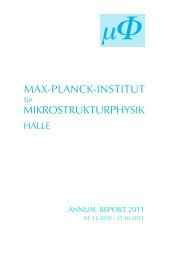Transition metals in photovoltaic-grade ingot-cast multicrystalline ...
Transition metals in photovoltaic-grade ingot-cast multicrystalline ...
Transition metals in photovoltaic-grade ingot-cast multicrystalline ...
Create successful ePaper yourself
Turn your PDF publications into a flip-book with our unique Google optimized e-Paper software.
Abstract<br />
Journal of Crystal Growth 287 (2006) 402–407<br />
<strong>Transition</strong> <strong>metals</strong> <strong>in</strong> <strong>photovoltaic</strong>-<strong>grade</strong> <strong>in</strong>got-<strong>cast</strong> multicrystall<strong>in</strong>e<br />
silicon: Assess<strong>in</strong>g the role of impurities <strong>in</strong> silicon nitride crucible<br />
l<strong>in</strong><strong>in</strong>g material $<br />
T. Buonassisi a , A.A. Istratov a, , M.D. Pickett a , J.-P. Rakotonia<strong>in</strong>a b , O. Breitenste<strong>in</strong> b ,<br />
M.A. Marcus c , S.M. Heald d , E.R. Weber a<br />
a Materials Science Division, Department of Materials Science and Eng<strong>in</strong>eer<strong>in</strong>g, Lawrence Berkeley National Laboratory,<br />
University of California, Berkeley, Build<strong>in</strong>g 62-109 (MS 62R0203), 1 Cyclotron Road, Berkeley, CA 94720, USA<br />
b Max Planck Institute of Microstructure Physics, Halle, Germany<br />
c Advanced Light Source, Lawrence Berkeley National Laboratory, Berkeley, CA 94720, USA<br />
d Advanced Photon Source, Argonne National Laboratory, Argonne, IL 60439, USA<br />
Available onl<strong>in</strong>e 4 January 2006<br />
We assess the contam<strong>in</strong>ation potential of crucibles used dur<strong>in</strong>g directionally solidified multicrystall<strong>in</strong>e silicon (mc-Si) <strong>in</strong>got <strong>cast</strong><strong>in</strong>g for<br />
cost-effective solar cell wafer production. Highly sensitive, synchrotron-based analytical microprobe techniques were used to study the<br />
distributions, sizes, elemental natures and chemical states of impurity-rich particles <strong>in</strong> a-Si3N4 powder representative of what is used to<br />
coat the <strong>in</strong>side of mc-Si <strong>in</strong>got-<strong>cast</strong><strong>in</strong>g crucibles, as well as the as-grown <strong>cast</strong> mc-Si material. Correlations between the elemental species,<br />
chemical states, particle sizes, relative concentrations and locations of impurities (e.g. Fe, Ti, Ca, Zn, Ni, Cu, N, C) concomitant <strong>in</strong> a-<br />
Si3N4 and as-grown mc-Si lead us to conclude that a-Si3N4 could be a significant source of contam<strong>in</strong>ants dur<strong>in</strong>g the <strong>in</strong>got-<strong>cast</strong><strong>in</strong>g mc-Si<br />
growth process.<br />
r 2005 Elsevier B.V. All rights reserved.<br />
PACS: 78.70; 61.72; 84.60<br />
Keywords: A1. Defects; A1. Impurities; A2. Directional solidification; B1. Nitrides; B2. Semiconduct<strong>in</strong>g silicon; B3. Solar cells<br />
1. Introduction<br />
Recent neutron activation analysis (NAA) studies<br />
revealed metal concentrations <strong>in</strong> <strong>in</strong>got-<strong>cast</strong> multicrystall<strong>in</strong>e<br />
silicon (mc-Si) materials as high as 10 13 –10 16 cm 3 (i.e., <strong>in</strong><br />
the ppb to ppm range) [1–3]. Subsequent studies [4,5]<br />
<strong>in</strong>dicated that the majority of <strong>metals</strong> are present either <strong>in</strong><br />
(a) metal silicide nanoprecipitates typically o100 nm <strong>in</strong><br />
diameter, composed of medium- or fast-diffus<strong>in</strong>g metal<br />
species, and present <strong>in</strong> high spatial densities (especially<br />
$ This manuscript corresponds to the <strong>in</strong>vited talk ‘‘<strong>Transition</strong> <strong>metals</strong> <strong>in</strong><br />
<strong>photovoltaic</strong>-<strong>grade</strong> multicrystall<strong>in</strong>e silicon’’ by A.A. Istratov, T. Buonassisi<br />
and E.R. Weber at ACCGE-16, Si/PV-1 session.<br />
Correspond<strong>in</strong>g author. Fax: +1 510 486 4995.<br />
E-mail address: istratov@berkeley.edu (A.A. Istratov).<br />
0022-0248/$ - see front matter r 2005 Elsevier B.V. All rights reserved.<br />
doi:10.1016/j.jcrysgro.2005.11.053<br />
ARTICLE IN PRESS<br />
www.elsevier.com/locate/jcrysgro<br />
along structural defects), or (b) larger particles up to<br />
several microns <strong>in</strong> size, often <strong>in</strong> an oxidized chemical state<br />
and/or conta<strong>in</strong><strong>in</strong>g multiple slowly diffus<strong>in</strong>g impurity<br />
species, present <strong>in</strong> low spatial densities. A model was<br />
developed [5] to expla<strong>in</strong> the presence of both types of<br />
particle <strong>in</strong> mc-Si—the metal silicide nanoprecipitates form<br />
from supersaturated metal atoms dissolved with<strong>in</strong> the melt<br />
or the crystal, while the micron-sized particles are likely to<br />
be <strong>in</strong>clusions of foreign particles that enter the melt and are<br />
<strong>in</strong>corporated by the advanc<strong>in</strong>g solidification front. Understand<strong>in</strong>g<br />
the sources and mechanisms of metal contam<strong>in</strong>ation<br />
is a vital first step to reduce metal contam<strong>in</strong>ation levels<br />
<strong>in</strong> mc-Si solar cells.<br />
In this manuscript, we assess the contam<strong>in</strong>ation potential<br />
of crucibles used dur<strong>in</strong>g directionally solidified mc-Si<br />
<strong>in</strong>got <strong>cast</strong><strong>in</strong>g (i.e. the technology that currently produces
over 50% of solar cells worldwide). This source of<br />
contam<strong>in</strong>ation is important for the <strong>cast</strong><strong>in</strong>g technology<br />
because of the prolonged contact (several tens of hours)<br />
between the crucible (usually a fused silica or graphite<br />
crucible l<strong>in</strong>ed with a silicon nitride coat<strong>in</strong>g) and the silicon<br />
melt/crystal dur<strong>in</strong>g <strong>in</strong>got production. If impurities are<br />
conta<strong>in</strong>ed with<strong>in</strong> any of the crucible parts, then contam<strong>in</strong>ation<br />
of the melt or of the cool<strong>in</strong>g <strong>in</strong>got may occur, as<br />
suggested by previous studies (e.g., Refs. [6–11]).<br />
2. Materials and methods<br />
Two types of material were analyzed <strong>in</strong> this study: (a) a-<br />
Si 3N 4 powder, and (b) as-grown mc-Si wafers produced<br />
from <strong>cast</strong> <strong>in</strong>gots.<br />
Samples of a-Si3N4 powder were obta<strong>in</strong>ed from commercial<br />
chemical suppliers (Alfa Aesar and Cerac) and<br />
from one of our <strong>in</strong>dustrial collaborators; the latter material<br />
is representative of what is used <strong>in</strong> <strong>in</strong>dustry to coat the<br />
<strong>in</strong>sides of mc-Si <strong>in</strong>got-<strong>cast</strong><strong>in</strong>g crucibles. Four types of<br />
commercial a-Si 3N 4 powders were analyzed, with vendorspecified<br />
purities rang<strong>in</strong>g from 95% to 99.9%, <strong>in</strong> addition<br />
to the <strong>in</strong>dustrial sample. Each type of powder was poured<br />
<strong>in</strong>to a small satchel of 5 mm-thick clean polymer and then<br />
attached to a sample stage. A background scan on an<br />
empty polymer satchel revealed no impurity particles above<br />
the detection limits, ensur<strong>in</strong>g that the impurity particles<br />
detected by m-XRF <strong>in</strong>deed orig<strong>in</strong>ated from the powder<br />
samples themselves.<br />
As-grown <strong>in</strong>got-<strong>cast</strong> mc-Si wafers were extracted from<br />
near the bottom, middle, top and edges of several <strong>in</strong>gots<br />
grown by different manufacturers. All samples were lightly<br />
etched to remove surface contam<strong>in</strong>ation before be<strong>in</strong>g<br />
measured by highly sensitive synchrotron-based techniques.<br />
One particular sample that conta<strong>in</strong>ed a high density<br />
of Si3N4 and SiC microdefects was cut vertically from the<br />
upper 2 cm of a directionally solidified <strong>in</strong>got, as described<br />
<strong>in</strong> Ref. [12]. The wafer was then polished down to<br />
0.25 mm mean surface roughness for study by <strong>in</strong>frared<br />
transmission microscopy. Dur<strong>in</strong>g the f<strong>in</strong>al stage of the<br />
polish<strong>in</strong>g process, it was noticed that some microdefects<br />
were revealed at the surface of the wafer and could be<br />
observed by an optical microscope. These ‘‘partially<br />
unburied’’ microdefects were selected for microanalysis<br />
by synchrotron-based techniques, after a light etch<strong>in</strong>g to<br />
remove surface contam<strong>in</strong>ants.<br />
Synchrotron-based X-ray fluorescence microscopy (m-<br />
XRF) was used to map distributions of impurity-rich<br />
particles, to identify their elemental compositions, and to<br />
determ<strong>in</strong>e their sizes. Once impurity-rich particles were<br />
located by m-XRF, their chemical states (e.g., oxide vs.<br />
silicide) were identified by the X-ray absorption microspectroscopy<br />
(m-XAS) technique. Details of these experimental<br />
techniques can be found <strong>in</strong> Refs. [4,5,13,23].<br />
To perform m-XRF/XAS measurements, we used beaml<strong>in</strong>e<br />
10.3.2 [14] of the Advanced Light Source at Lawrence<br />
Berkeley National Laboratory, and beaml<strong>in</strong>e 20-ID-B [15]<br />
ARTICLE IN PRESS<br />
T. Buonassisi et al. / Journal of Crystal Growth 287 (2006) 402–407 403<br />
at the Advanced Photon Source of Argonne National<br />
Laboratory.<br />
Infrared transmission microscopy (IRTM, performed at<br />
MPI Halle) was used to locate Si3N4 and SiC microdefects<br />
and to observe their structures, which were then correlated<br />
to transmission electron microscopy measurements on<br />
similar samples to determ<strong>in</strong>e their chemical compositions.<br />
Energy dispersive X-ray microanalysis (EDX, performed at<br />
MPI Halle) confirmed the presence of C and N at these<br />
microdefects.<br />
3. Results<br />
3.1. a-Si 3N 4 crucible l<strong>in</strong><strong>in</strong>g material<br />
The total impurity contents of a-Si3N4 powders from<br />
commercial suppliers were obta<strong>in</strong>ed by <strong>in</strong>ductively coupled<br />
plasma optical emission spectroscopy (ICP-OES, performed<br />
by the vendors). Fig. 1a shows the results of these<br />
analyses, i.e., the most common impurities <strong>in</strong> a-Si3N4.<br />
Interest<strong>in</strong>gly, most major impurities, as well as their<br />
concentrations, are very similar to those reported [16,17]<br />
<strong>in</strong> a-Si3N4 powders studied dur<strong>in</strong>g the 1970s.<br />
For comparison, Fig. 1b shows impurity content of<br />
<strong>in</strong>got-<strong>cast</strong> mc-Si as determ<strong>in</strong>ed by NAA. Not all elements<br />
detected by ICP-OES and plotted <strong>in</strong> Fig. 1a could be<br />
detected <strong>in</strong> mc-Si by NAA, because NAA is not equally<br />
sensitive to all elements [18], and vice versa; hence, the lack<br />
of bars <strong>in</strong> Fig. 1(a) or (b) correspond<strong>in</strong>g to certa<strong>in</strong> elements<br />
does not imply that these elements were not present, but<br />
Fig. 1. (a) Vendor-specified impurity contents of four different commercially<br />
available a-Si 3N 4 powders with purities between 95% and 99.9%.<br />
The range of variation, which depends on the purity of the powder, is<br />
shown by the error bars. (b) Impurity content of different directionally<br />
solidified <strong>in</strong>got-grown mc-Si materials determ<strong>in</strong>ed by NAA [1–3]. The<br />
error bars show the range of values obta<strong>in</strong>ed on different samples.
404<br />
rather means that they could not be detected by a<br />
particular analytical technique. The m-XRF technique,<br />
used <strong>in</strong> our experiments to map distributions of impurities,<br />
can easily detect elements such as Fe and Ca, which are<br />
some of the most abundant metal impurities, but cannot<br />
readily detect lighter elements such as O, N, C and Al, s<strong>in</strong>ce<br />
their fluorescence energies are below 1.5 keV and are<br />
strongly absorbed by silicon and air.<br />
Fig. 2 shows a m-XRF map of Fe and Ca distributions <strong>in</strong><br />
an a-Si3N4 powder provided by our <strong>in</strong>dustrial collaborator,<br />
and typical of what is used <strong>in</strong> <strong>in</strong>dustry to coat the <strong>in</strong>got<strong>cast</strong><strong>in</strong>g<br />
crucibles. Similar distributions were observed <strong>in</strong> the<br />
powders purchased from commercial vendors. In such<br />
powders, iron can be found both distributed homogeneously<br />
as well as concentrated <strong>in</strong> discrete small and large<br />
particles. The homogeneously distributed background iron<br />
concentration is most readily detectable <strong>in</strong> lower-purity a-<br />
Si3N4, and is determ<strong>in</strong>ed by m-XAS to be <strong>in</strong> the FeSi2<br />
chemical state. In addition, discrete Fe-rich particles can be<br />
observed <strong>in</strong> all a-Si3N4 materials. The sizes and abundances<br />
Fig. 2. m-XRF map of a-Si3N4 powder (representative of what is used <strong>in</strong><br />
<strong>in</strong>dustry to coat <strong>cast</strong><strong>in</strong>g crucibles) reveals the spatial distribution of ironand<br />
calcium-rich particles. Both large and small iron-rich particles are<br />
observed. Large Fe-rich particles (such as the one at X ¼ 0:7 mm,<br />
Y ¼ 0:5 mm) conta<strong>in</strong> only iron <strong>in</strong> a chemical state most similar to<br />
Fe 2O 3 (Fig. 3a). The smaller particles consist of Fe+Ni+Cr (Fig. 4), with<br />
iron <strong>in</strong> a Fe 0 charge state, i.e. most similar to metallic Fe (Fig. 3b).<br />
Background Fe, detectable <strong>in</strong> some lower-purity a-Si3N4 powders, is<br />
determ<strong>in</strong>ed to be FeSi 2. More isolated particles conta<strong>in</strong><strong>in</strong>g Cu metal, Zn,<br />
Ti, Cr, Ni and Co were also observed.<br />
ARTICLE IN PRESS<br />
T. Buonassisi et al. / Journal of Crystal Growth 287 (2006) 402–407<br />
of these particles decrease with <strong>in</strong>creas<strong>in</strong>g powder purity;<br />
the <strong>in</strong>dustrial sample demonstrated particle sizes and<br />
abundances comparable to the higher-purity commercial<br />
samples. These particles exist <strong>in</strong> two varieties—larger<br />
particles of a chemical state most similar to Fe 2O 3<br />
(Fig. 3a), and smaller particles of Fe+Cr+Ni (rem<strong>in</strong>iscent<br />
of sta<strong>in</strong>less steel, Fig. 4) with iron <strong>in</strong> an Fe 0 charge state<br />
(such as <strong>in</strong> iron silicide, metallic iron, iron carbide, etc.)<br />
(Fig. 3b). Other less-frequently observed impurity-rich<br />
particles conta<strong>in</strong> Cu metal, Zn, Ti, Cr, Ni, Co or Ca. All<br />
a-Si3N4 powders analyzed <strong>in</strong> this study exhibit at least two<br />
of these types of particle, <strong>in</strong> addition to the more abundant<br />
Fe-rich particles.<br />
Fig. 3. m-XAS spectra of two types of Fe-rich particle <strong>in</strong> a-Si 3N 4 material.<br />
The particle <strong>in</strong> (a) conta<strong>in</strong>s a large amount of iron (Fig. 2), and the<br />
chemical state is most similar to iron oxide (Fe2O3). The particle <strong>in</strong> (b)<br />
consists of Cr, Ni and Fe (Figs. 2 and 4), and the near-edge features match<br />
most closely with those of iron <strong>in</strong> the Fe 0 charge state (e.g. Fe metal, Fe<br />
silicide), although the extended X-ray absorption f<strong>in</strong>e spectrum does not<br />
match perfectly with any of the standards. Note that the m-XAS of the<br />
oxidized iron particle found <strong>in</strong> a-Si 3N 4 and that of an oxidized iron<br />
<strong>in</strong>clusion detected <strong>in</strong> <strong>in</strong>got-<strong>cast</strong> mc-Si material match nearly perfectly,<br />
<strong>in</strong>dicat<strong>in</strong>g that both the charge state and local crystallographic environment<br />
are nearly identical, and provid<strong>in</strong>g strong evidence that metal-rich<br />
particles <strong>in</strong> the a-Si 3N 4 crucible l<strong>in</strong><strong>in</strong>g material can enter the melt dur<strong>in</strong>g<br />
growth.
Fig. 4. Typical m-XRF po<strong>in</strong>t spectrum of the smaller Fe-rich particles <strong>in</strong><br />
Fig. 2. Iron, chromium and nickel are present <strong>in</strong> proportions suggestive of<br />
sta<strong>in</strong>less steel. The m-XAS spectrum for this particle appears <strong>in</strong> Fig. 3b.<br />
3.2. Metals <strong>in</strong> <strong>in</strong>got-<strong>cast</strong> mc-Si<br />
The spatial distributions and chemical states of metalrich<br />
particles <strong>in</strong> <strong>in</strong>got-<strong>cast</strong> mc-Si turned out to be very<br />
similar to those <strong>in</strong> the silicon nitride coat<strong>in</strong>g. In <strong>in</strong>got-<strong>cast</strong><br />
mc-Si, three types of impurity-rich particle are observed by<br />
our experimental techniques: (a) metal silicide nanoprecipitates,<br />
typically 30–60 nm <strong>in</strong> diameter, most often found<br />
along structural defects (especially gra<strong>in</strong> boundaries), (b)<br />
metal-rich <strong>in</strong>clusions, often measur<strong>in</strong>g up to a few tens of<br />
microns <strong>in</strong> diameter, and (c) extended microdefects (e.g.,<br />
silicon carbide or nitride) measur<strong>in</strong>g up to several tens or<br />
hundred of microns <strong>in</strong> diameter. Note that the experimental<br />
techniques used <strong>in</strong> this study are <strong>in</strong>sensitive to most<br />
metal po<strong>in</strong>t defects, such as <strong>in</strong>dividual <strong>in</strong>terstitial or<br />
substitutional metal atoms.<br />
The metal silicide nanoprecipitates detected <strong>in</strong> <strong>in</strong>got-<strong>cast</strong><br />
mc-Si are usually found at structural defects (e.g., gra<strong>in</strong><br />
boundaries) and typically conta<strong>in</strong> Ni, Fe, Cu and/or Co,<br />
<strong>in</strong>cidentally the 3d transition metal species with highest<br />
solubilities and diffusivities <strong>in</strong> silicon. Further details on<br />
structure and properties of metal particles <strong>in</strong> silicon can be<br />
found <strong>in</strong> our recent publications [4,5,19]. A much higher<br />
concentration of these precipitates is observed towards the<br />
bottom, top and edges of the <strong>in</strong>got. The total amount of<br />
<strong>metals</strong> conta<strong>in</strong>ed <strong>in</strong> these precipitates is estimated by m-<br />
XRF to reach values as high as 3 10 14 cm 3 [5] or higher.<br />
On the other hand, <strong>in</strong> the middle of the <strong>in</strong>got, such<br />
precipitates are rarely observed above the current m-XRF<br />
detection limits.<br />
Micron-sized particles <strong>in</strong> mc-Si are often composed of<br />
oxidized Fe or Ti (an example of such particle is shown <strong>in</strong><br />
Ref. [5]). In addition, particles conta<strong>in</strong><strong>in</strong>g Ca, Zn, Mn, Mo<br />
and/or Cr, with traces of fast diffusers were also observed.<br />
The abundance of slowly diffus<strong>in</strong>g elements, comb<strong>in</strong>ed<br />
with their frequently oxidized chemical state lead us to<br />
conclude that these particles are <strong>in</strong>clusions and not<br />
precipitates [4,5]. The spatial density of these particles is<br />
orders of magnitude lower than metal silicide nanoprecipitates.<br />
However, each <strong>in</strong>clusion particle conta<strong>in</strong>s a far<br />
ARTICLE IN PRESS<br />
T. Buonassisi et al. / Journal of Crystal Growth 287 (2006) 402–407 405<br />
Fig. 5. (a) IRTM image of a b-Si3N4 rod encircled by SiC clusters, found<br />
<strong>in</strong> the upper part of a <strong>cast</strong> mc-Si <strong>in</strong>got; (b–d) m-XRF maps of the same<br />
region. Homogeneously distributed Ca and FeSi 2 are present at the<br />
b-Si3N4 rod. Particles of FeSi2 and Cu3Si are also present at the SiC<br />
clusters. All of these impurities are also present <strong>in</strong> a-Si3N4 powder <strong>in</strong> high<br />
concentrations (Figs. 1 and 2).<br />
greater number of metal atoms than a metal silicide<br />
nanopreciptiate. Consequently, these particles were found<br />
to account for local metal contents as high as<br />
2.3 10 16 cm 3 [5] <strong>in</strong> regions of the <strong>in</strong>got where they are<br />
most prevalent (top, bottom and edges).<br />
Metals are also found at Si 3N 4 and SiC microdefects<br />
towards the top of the <strong>in</strong>got. These microdefects are<br />
specific for <strong>in</strong>got-<strong>cast</strong> mc-Si; the significance of f<strong>in</strong>d<strong>in</strong>g<br />
these microdefects is discussed below. An IRTM image<br />
(Fig. 5a) of one collection of microdefects reveals a b-Si3N4<br />
rod surrounded by several b-SiC clusters. FeSi2 and Ca<br />
(chemical state not determ<strong>in</strong>ed) are found rather homogeneously<br />
distributed with<strong>in</strong> the b-Si3N4 rod (Figs. 5b,d),<br />
while FeSi 2 and Cu 3Si particles are observed with<strong>in</strong> the SiC<br />
clusters surround<strong>in</strong>g the Si 3N 4 rods (Figs. 5(c) and (d)).<br />
4. Discussion and conclusions<br />
The results presented <strong>in</strong> this study strongly <strong>in</strong>dicate that<br />
the silicon nitride coat<strong>in</strong>g could contam<strong>in</strong>ate <strong>cast</strong> mc-Si<br />
<strong>in</strong>gots with an assortment of metallic and non-metallic<br />
impurities dur<strong>in</strong>g crystal growth. Firstly, the relative<br />
concentrations of elemental impurity species <strong>in</strong> a-Si 3N 4 are<br />
similar to those impurities found <strong>in</strong> <strong>in</strong>got-<strong>cast</strong> mc-Si, as<br />
shown <strong>in</strong> Fig. 1. It must be noted that the bulk impurity<br />
concentrations <strong>in</strong> the nitride coat<strong>in</strong>g and <strong>in</strong>got-<strong>cast</strong> mc-Si<br />
wafers were measured us<strong>in</strong>g different experimental techniques,<br />
each sensitive to a different set of elements (e.g.,<br />
NAA is not well-suited to detect low-Z elements such as<br />
carbon and nitrogen, but it has better sensitivity than ICP-<br />
OES to some transition <strong>metals</strong>). Secondly, the chemical<br />
states of certa<strong>in</strong> impurity-rich particles <strong>in</strong> a-Si 3N 4 and<br />
<strong>in</strong>clusions <strong>in</strong> <strong>in</strong>got-<strong>cast</strong> mc-Si are practically identical,<br />
as shown <strong>in</strong> the overlapp<strong>in</strong>g m-XAS spectra <strong>in</strong> Fig. 3a.<br />
Thirdly, the distribution of impurities <strong>in</strong> <strong>in</strong>got-<strong>cast</strong> mc-Si
406<br />
<strong>in</strong>gots suggests an external contam<strong>in</strong>ation source <strong>in</strong> contact<br />
with the melt and crystal, given the predom<strong>in</strong>ance of<br />
precipitates and <strong>in</strong>clusions near the side edges of <strong>in</strong>gots.<br />
Fourthly, the observation of silicon nitride and silicon<br />
carbide microdefects <strong>in</strong> the upper regions of the <strong>in</strong>got<br />
reflects high concentrations of carbon and nitrogen<br />
impurities <strong>in</strong> the melt. (The precise formation mechanisms<br />
of these microdefects is complex and the subject of separate<br />
discussions [7,12,20], but it is generally believed that<br />
dissolved nitrogen and carbon become supersaturated <strong>in</strong><br />
the melt dur<strong>in</strong>g the latter stages of <strong>in</strong>got growth, lead<strong>in</strong>g to<br />
the formation of these microdefects). Dur<strong>in</strong>g directionally<br />
solidified <strong>cast</strong> mc-Si <strong>in</strong>got growth, nitride and carbide<br />
particles likely decompose from the crucible l<strong>in</strong><strong>in</strong>g material<br />
<strong>in</strong> contact with the melt. This is consistent with the<br />
observation that mc-Si materials not grown <strong>in</strong> Si3N4coated<br />
crucibles seldom exhibit silicon nitride and silicon<br />
carbide microdefects, with the exception of silicon carbide<br />
microdefects observed <strong>in</strong> mc-Si materials grown us<strong>in</strong>g<br />
graphite crucible parts [21] or growth substrates [22]. Upon<br />
decomposition of the silicon nitride crucible l<strong>in</strong><strong>in</strong>g material<br />
<strong>in</strong> contact with the melt, other impurity atoms or particles<br />
associated with the nitride can also enter <strong>in</strong>to the melt. This<br />
hypothesis is strongly supported by the concomitant<br />
presence of N, C, Fe, Ca and Cu at these microdefects<br />
(Fig. 5) and with<strong>in</strong> a-Si3N4 powders (Figs. 1, 2).<br />
These data suggest two possible mechanisms of <strong>in</strong>corporat<strong>in</strong>g<br />
impurities from the crucible l<strong>in</strong><strong>in</strong>g material<br />
coat<strong>in</strong>g <strong>in</strong>to mc-Si:<br />
(1) Impurity atoms and impurity-rich particles <strong>in</strong> the a-<br />
Si3N4 may dissolve <strong>in</strong>to the silicon melt or warm crystal<br />
and form metal po<strong>in</strong>t defects, precipitates and/or<br />
microdefects. This mechanism likely dom<strong>in</strong>ates for<br />
small particles (e.g. Fe+Cr+Ni-rich particles), particles<br />
with low melt<strong>in</strong>g temperatures and impurities<br />
distributed atomically or <strong>in</strong> very small clusters (e.g.<br />
background FeSi 2 <strong>in</strong> lower-purity a-Si 3N 4).<br />
(2) Impurity-rich particles <strong>in</strong> the a-Si3N4 may be wholly<br />
<strong>in</strong>corporated <strong>in</strong>to the melt as second-phase particles. If<br />
these particles exist for only a short time <strong>in</strong> the melt,<br />
and/or if the melt is already saturated with the given<br />
impurity species, then these second-phase particles can<br />
be <strong>in</strong>corporated <strong>in</strong>to the advanc<strong>in</strong>g solidification front<br />
as <strong>in</strong>clusions. This is likely to be the case for the<br />
relatively large (diameter X1 mm) oxide-like iron<br />
particles occasionally observed <strong>in</strong> a-Si3N4 and near<br />
the edges, top, and bottom of mc-Si <strong>in</strong>gots. It is also<br />
possible that certa<strong>in</strong> microdefects are formed this way<br />
[7,12,20].<br />
The concentration of impurities <strong>in</strong> the melt dissolv<strong>in</strong>g<br />
from the a-Si 3N 4 coat<strong>in</strong>g depends on the total thickness of<br />
a-Si 3N 4 that dissolves dur<strong>in</strong>g crystal growth, the elements<br />
that may be added dur<strong>in</strong>g the coat<strong>in</strong>g process as s<strong>in</strong>ter<strong>in</strong>g<br />
aid, as well as on the surface area to volume ratio of the<br />
crucible. Effective means of reduc<strong>in</strong>g the impact of this<br />
ARTICLE IN PRESS<br />
T. Buonassisi et al. / Journal of Crystal Growth 287 (2006) 402–407<br />
contam<strong>in</strong>ation source on <strong>in</strong>got-<strong>cast</strong> mc-Si might <strong>in</strong>clude<br />
reduc<strong>in</strong>g the impurity content <strong>in</strong> a-Si3N4, improv<strong>in</strong>g the<br />
structural quality of Si3N4 to m<strong>in</strong>imize its decomposition<br />
dur<strong>in</strong>g growth and reduc<strong>in</strong>g the surface area to volume<br />
ratio of the crucible (e.g. <strong>in</strong>creas<strong>in</strong>g the crucible size).<br />
Acknowledgments<br />
The beaml<strong>in</strong>e assistance of S. Fakra is gratefully<br />
acknowledged. M. Werner (MPI Halle) is gratefully<br />
acknowledged for support<strong>in</strong>g discussions of TEM results.<br />
This study was supported by NREL subcontract AAT-2-<br />
31605-03. T.B. thanks German Academic Exchange<br />
Service (DAAD) for a summer research fellowship. The<br />
operations of the Advanced Light Source at Lawrence<br />
Berkeley National Laboratory are supported by the<br />
Director, Office of Science, Office of Basic Energy Sciences,<br />
Materials Sciences Division, of the US Department of<br />
Energy under Contract no. DEAC03-76SF00098. Use of<br />
the Advanced Photon Source was supported by the US<br />
Department of Energy, Office of Science, Office of Basic<br />
Energy Sciences, under Contract no. W-31-109-ENG-38.<br />
References<br />
[1] A.A. Istratov, T. Buonassisi, R.J. McDonald, A.R. Smith, R.<br />
Sch<strong>in</strong>dler, J.A. Rand, J.P. Kalejs, E.R. Weber, J. Appl. Phys. 94<br />
(2003) 6552.<br />
[2] D. Macdonald, A. Cuevas, A. K<strong>in</strong>omura, Y. Nakano, L.J. Geerligs,<br />
J. Appl. Phys. 97 (2005) 33523.<br />
[3] D. Macdonald, A. Cuevas, A. K<strong>in</strong>omura, Y. Nakano, <strong>in</strong>: 29th<br />
Photovoltaic Specialists Conference, IEEE, New Orleans, LA, 2002,<br />
p. 285.<br />
[4] T. Buonassisi, M.A. Marcus, A.A. Istratov, M. Heuer, T.F. Ciszek,<br />
B. Lai, C. Zhonghou, E.R. Weber, J. Appl. Phys. 97 (2005) 63503.<br />
[5] T. Buonassisi, A.A. Istratov, M. Heuer, M.A. Marcus, R. Jonczyk,<br />
J. Isenberg, B. Lai, C. Zhonghou, S. Heald, W. Warta, R. Sch<strong>in</strong>dler,<br />
G. Willeke, E.R. Weber, J. Appl. Phys. 97 (2005) 74901.<br />
[6] S. B<strong>in</strong>etti, M. Acciarri, C. Savigni, A. Brianza, S. Pizz<strong>in</strong>i, A. Mus<strong>in</strong>u,<br />
Mater. Sci. Eng. B 36 (1996) 68.<br />
[7] A.K. Soiland, E.J. Ovrelid, T.A. Engh, O. Lohne, J.K. Tuset,<br />
O. Gjerstad, Mater. Sci. Semicond. Process. 7 (2004) 39.<br />
[8] O. Breitenste<strong>in</strong>, J.P. Rakotonia<strong>in</strong>a, M.H.A. Rifai, M. Werner, Progr.<br />
Photovoltaics: Res. Appl. 12 (2004) 529.<br />
[9] M. Ghosh, D. Yang, A. Lawerenz, S. Riedel, H.J. Mo¨ller, <strong>in</strong>: 14th<br />
European Photovoltaic Solar Energy Conference and Exhibition,<br />
Barcelona, Spa<strong>in</strong>, 1997, p. 724.<br />
[10] C. Ballif, S. Peters, C. Borchert, C. Ha¨ssler, J. Isenberg, R. Sch<strong>in</strong>dler,<br />
W. Warta, G. Willeke, <strong>in</strong>: 17th European Photovoltaics Specialists<br />
Conference, Munich, Germany, 2001, p. 1818.<br />
[11] M. R<strong>in</strong>io, C. Ballif, T. Buonassisi, C. Borchert, <strong>in</strong>: 19th European<br />
Photovoltaic Solar Energy Conference, Paris, France, 2004,<br />
p. 762.<br />
[12] J.P. Rakotonia<strong>in</strong>a, O. Breitenste<strong>in</strong>, M. Werner, M. Hejjo Al-Rifai,<br />
T. Buonassisi, M.D. Pickett, M. Ghosh, A. Mu¨ller, N. Le Quang, <strong>in</strong>:<br />
Proceed<strong>in</strong>gs of the 20th European Photovoltaic Specialists Conference<br />
and Exhibition, Barcelona, Spa<strong>in</strong>, 2005, pp. 773–776.<br />
[13] S.A. McHugo, A.C. Thompson, C. Fl<strong>in</strong>k, E.R. Weber, G. Lamble,<br />
B. Gunion, A. MacDowell, R. Celestre, H.A. Padmore, Z. Hussa<strong>in</strong>,<br />
J. Crystal Growth 210 (2000) 395.<br />
[14] M.A. Marcus, A.A. MacDowell, R. Celestre, A. Manceau, T. Miller,<br />
H.A. Padmore, R.E. Sublett, J. Synchrotron Radiat. 11 (2004) 239.
[15] S. Heald, E. Stern, D. Brewe, R. Gordon, D. Crozier, J. Detong,<br />
J. Cross, J. Synchrotron Radiat. 8 (2001) 342.<br />
[16] J.L. Iskoe, F.F. Lange, E.S. Diaz, J. Mater. Sci. 11 (1976) 908.<br />
[17] D.P. Elias, M.W. L<strong>in</strong>dley, J. Mater. Sci. 11 (1976) 1278.<br />
[18] A.R. Smith, R.J. McDonald, H. Man<strong>in</strong>i, D.L. Hurley, E.B. Norman,<br />
M.C. Vella, R.W. Odom, J. Electrochem. Soc. 143 (1996) 339.<br />
[19] T. Buonassisi, A.A. Istratov, M.D. Pickett, M. Heuer, J.P. Kalejs,<br />
G. Hahn, M.A. Marcus, B. Lai, Z. Cai, S.M. Heald, T.F. Ciszek,<br />
ARTICLE IN PRESS<br />
T. Buonassisi et al. / Journal of Crystal Growth 287 (2006) 402–407 407<br />
R.F. Clark, D.W. Cunn<strong>in</strong>gham, A.M. Gabor, R. Jonczyk, S. Narayanan,<br />
E. Sauar, E.R. Weber, Progr. Photovoltaics: Res. Appl. (2006) <strong>in</strong> press.<br />
[20] O. Breitenste<strong>in</strong>, unpublished, 2005.<br />
[21] J.P. Kalejs, B. Bathey, C. Dube, J. Crystal Growth 109 (1991) 174.<br />
[22] H. Gottschalk, Phys. Stat. Sol. B 222 (2000) 353.<br />
[23] T. Buonassisi, A.A. Istratov, M.A. Marcus, M. Heuer, M.D. Pickett,<br />
B. Lai, Z. Cai, S.M. Heald, E.R. Weber, Solid State Phenom.<br />
108–109 (2005) 577.


